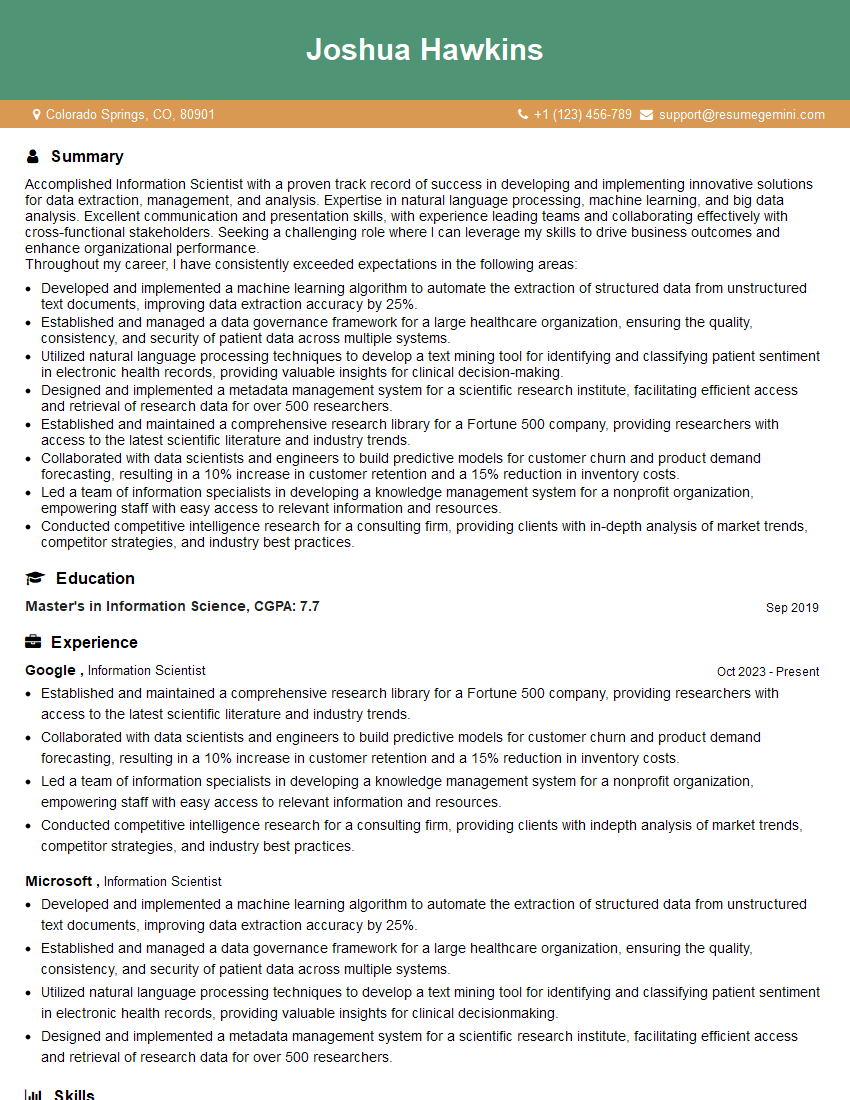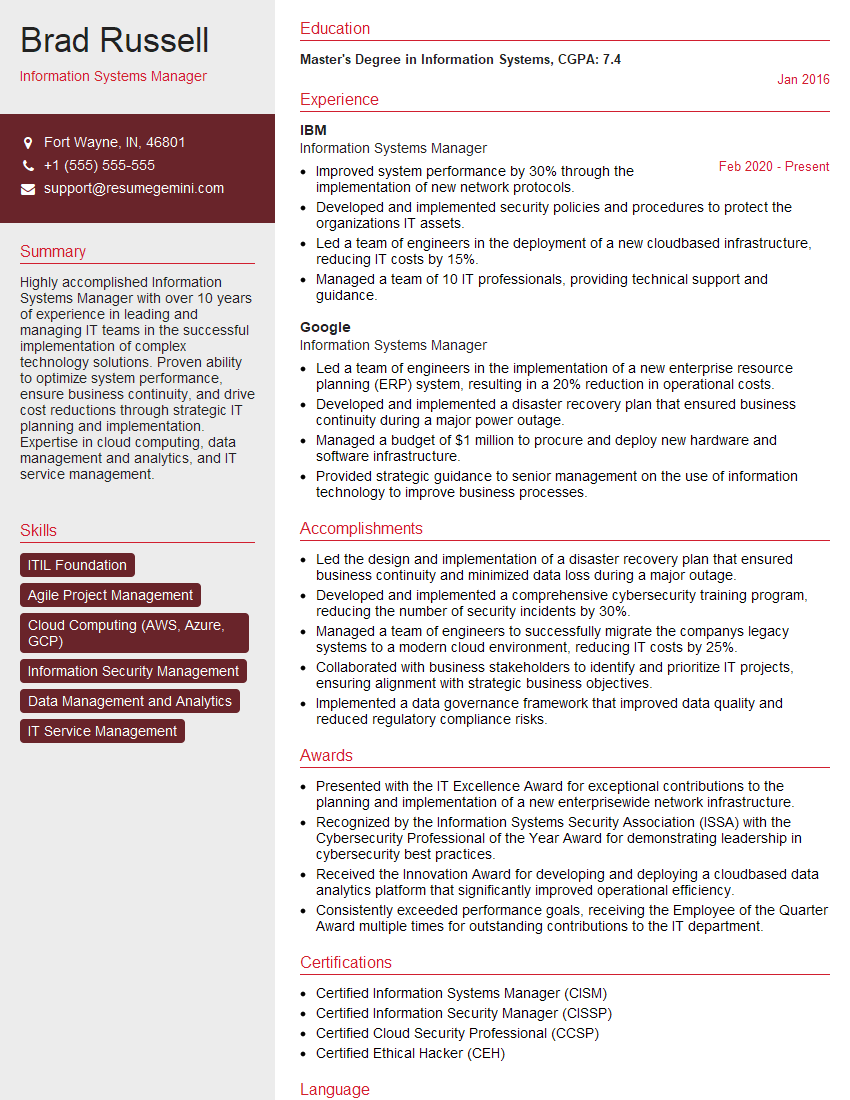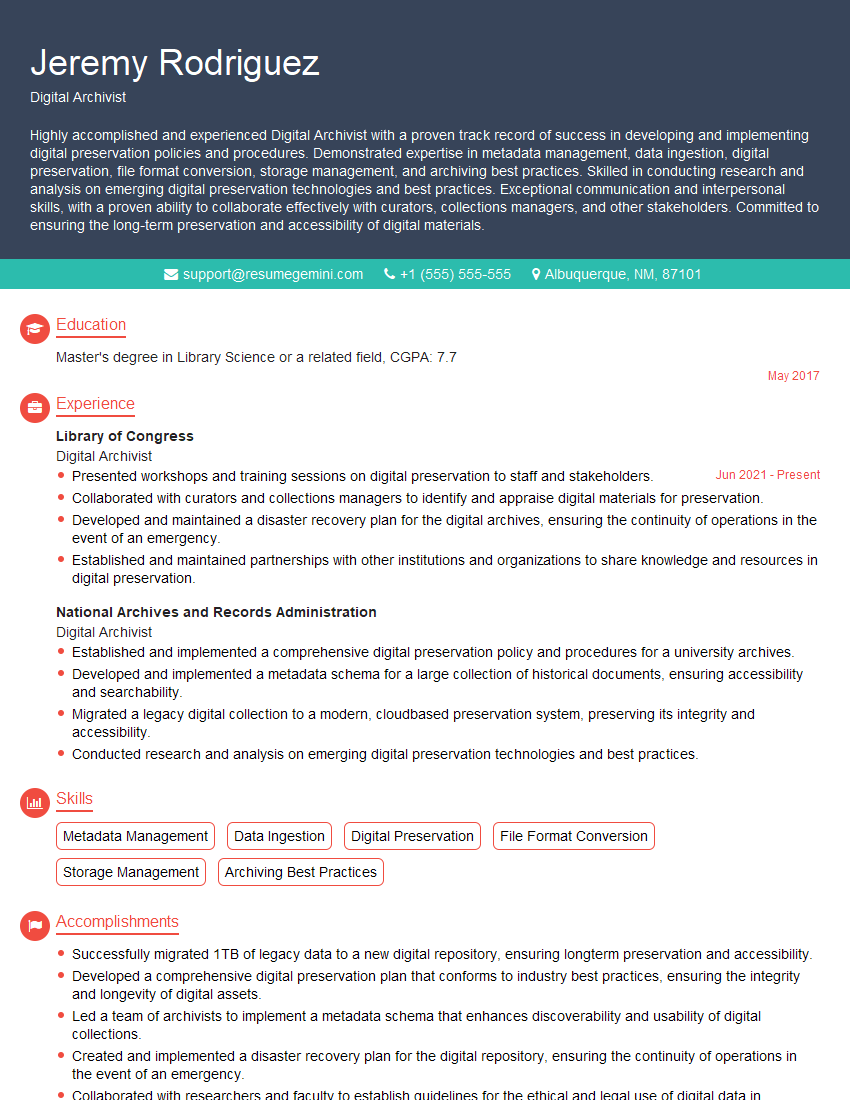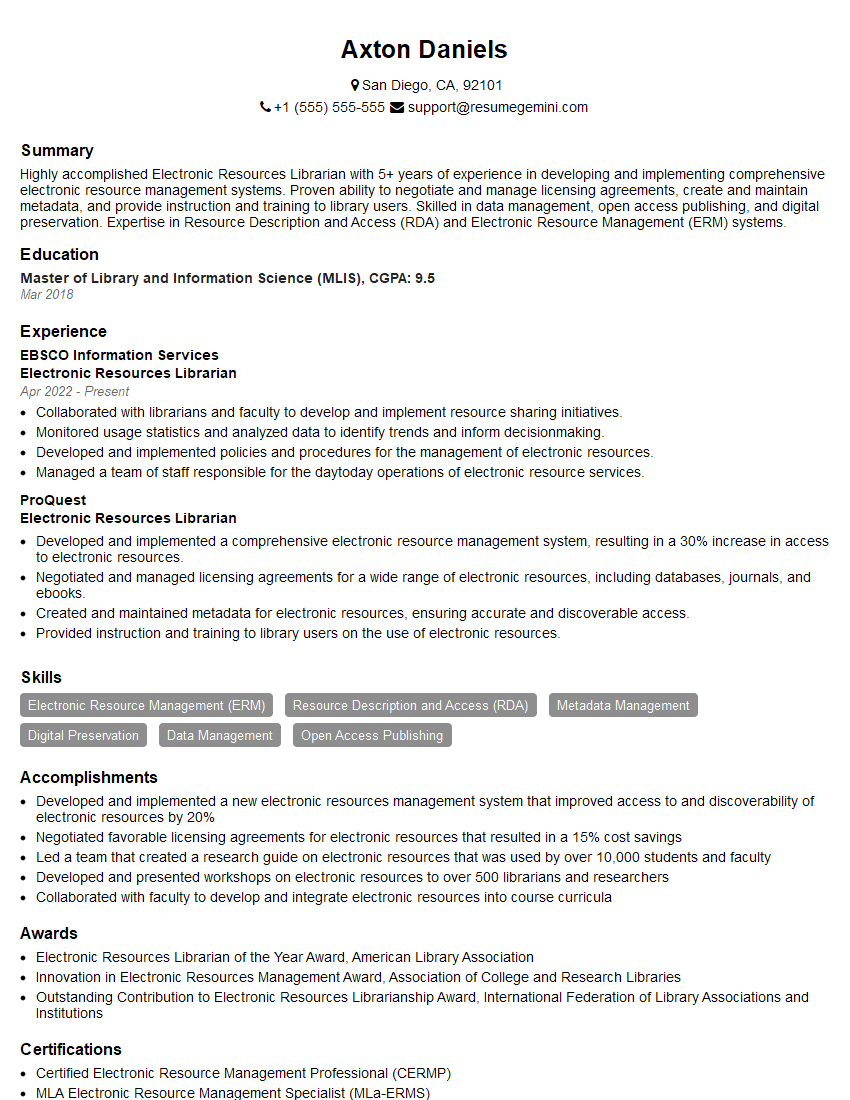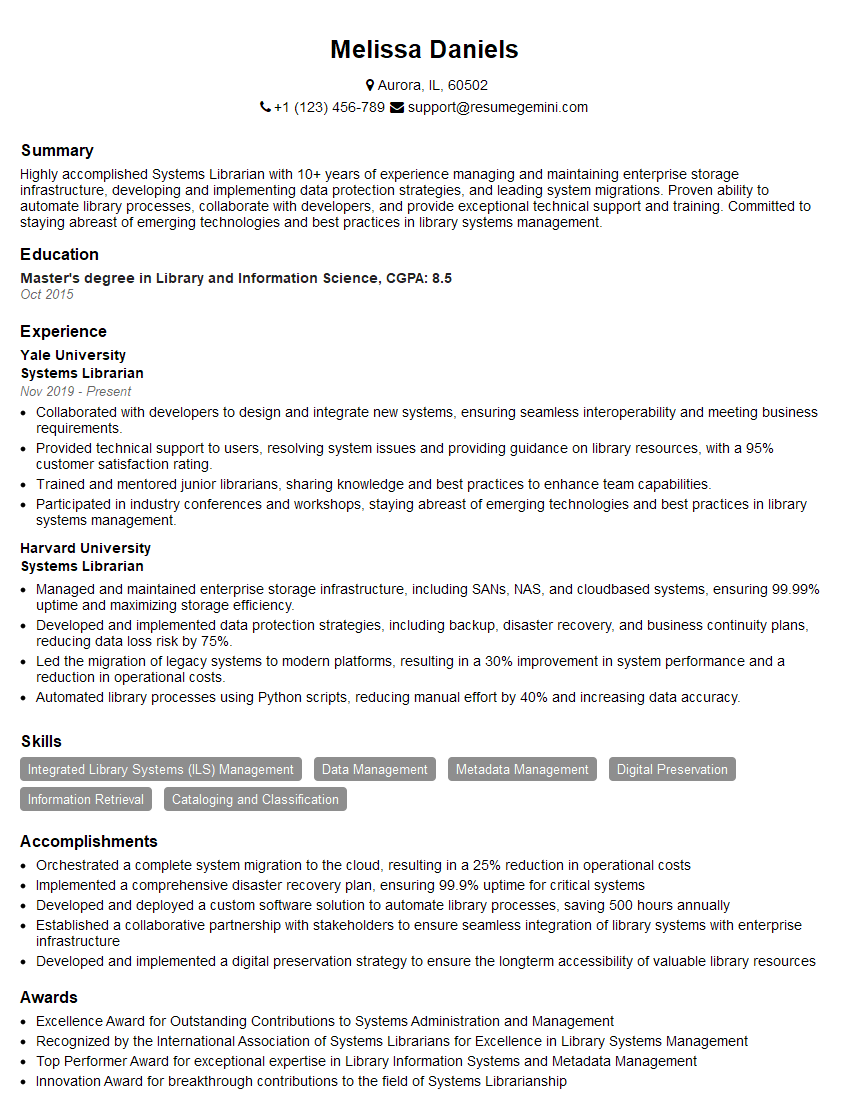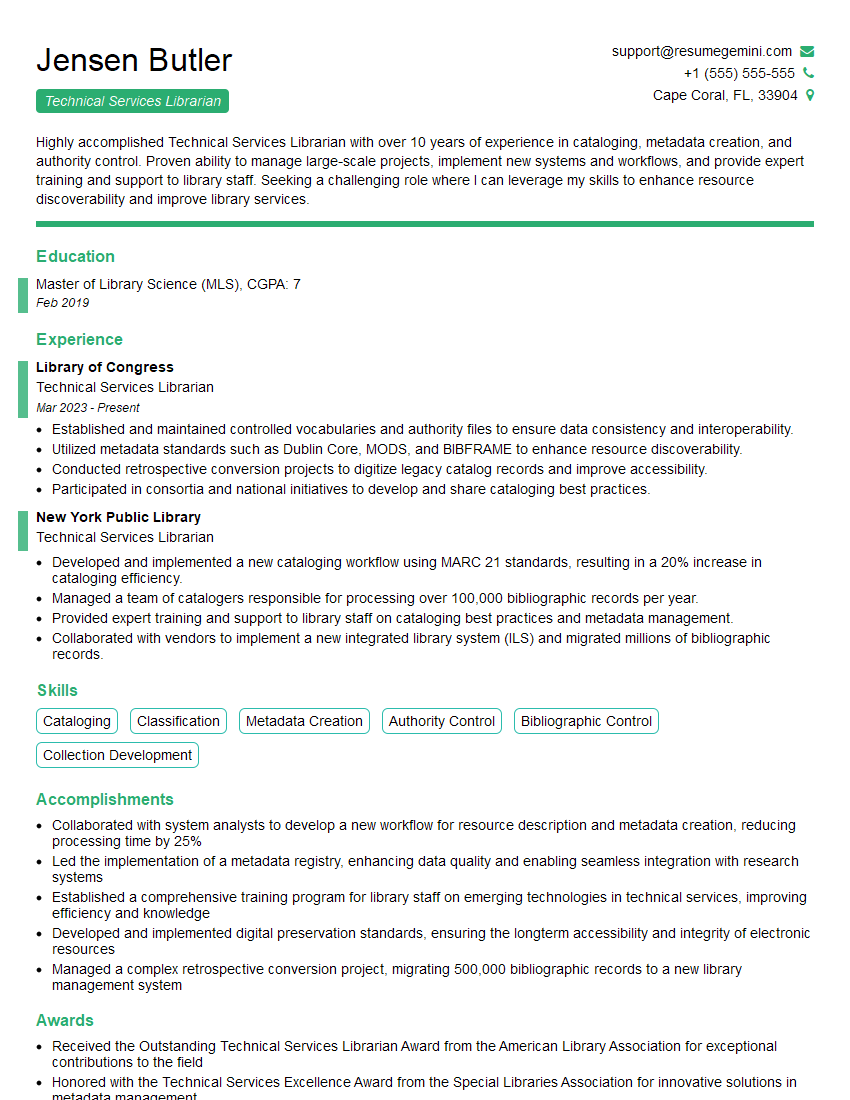Unlock your full potential by mastering the most common Knowledge of electronic book and journal platforms interview questions. This blog offers a deep dive into the critical topics, ensuring you’re not only prepared to answer but to excel. With these insights, you’ll approach your interview with clarity and confidence.
Questions Asked in Knowledge of electronic book and journal platforms Interview
Q 1. Describe your experience with various electronic book platforms (e.g., EBSCOhost, JSTOR, ProQuest).
My experience with electronic book platforms like EBSCOhost, JSTOR, and ProQuest spans over eight years, encompassing everything from basic searching and article retrieval to advanced functionalities like creating custom alerts and managing personal libraries within these platforms. I’ve utilized EBSCOhost extensively for its comprehensive collection of databases across various disciplines, leveraging its powerful search capabilities for targeted research. JSTOR has been invaluable for accessing historical journals and primary source materials, particularly in the humanities. ProQuest, with its vast dissertation and thesis collection, has been crucial for supporting graduate students’ research. I’m proficient in navigating the unique interfaces of each platform, understanding their respective strengths and limitations regarding search strategies, content organization, and citation management tools.
For example, while EBSCOhost excels in its broad coverage and user-friendly interface, JSTOR’s strength lies in its archival content. I’ve used this knowledge to strategically choose the appropriate platform based on the specific research needs of my users, ensuring they access the most relevant and reliable information efficiently.
Q 2. Explain the differences between subscription-based and open-access journal platforms.
The core difference between subscription-based and open-access journal platforms lies in how access is granted. Subscription-based platforms, like many databases within EBSCOhost or JSTOR, require institutions or individuals to pay a fee for access to their content. Think of it like a Netflix subscription—you pay for the privilege of watching their movies. The institution typically negotiates a license agreement with the publisher, granting access to a defined set of journals.
Open-access platforms, on the other hand, provide free access to their content for anyone, anywhere, without any subscription fees. This is akin to watching videos on YouTube; the content is freely available to all. While open access is beneficial for broader dissemination of research, it often relies on alternative funding models, like author fees (APC) or institutional support.
The key implications are cost and accessibility. Subscription models ensure publishers’ revenue but limit access based on affordability, while open access improves access but often requires different funding mechanisms.
Q 3. How familiar are you with metadata schemas used in electronic resources (e.g., Dublin Core, MARC)?
I’m very familiar with metadata schemas like Dublin Core and MARC, which are fundamental to the organization and discovery of electronic resources. Dublin Core, with its simple and flexible structure, is widely used to describe resources using elements such as title, author, subject, and date. It provides a basic level of metadata for improved searchability and interoperability across different systems.
MARC (Machine-Readable Cataloging) is a more complex and extensive standard, typically used in library catalogs. It provides a much richer set of fields for detailed cataloging and descriptive information, crucial for comprehensive resource management. Understanding these schemas allows me to effectively manage metadata within library systems, ensuring accurate indexing, retrieval, and interoperability with other digital libraries.
For example, my experience includes working with the Dublin Core metadata within a digital repository to ensure proper indexing and searchability. I also have expertise in manipulating and importing MARC records into library management systems for comprehensive cataloging.
Q 4. What are your experiences with managing electronic resource licenses and agreements?
Managing electronic resource licenses and agreements is a critical aspect of my role. This involves reviewing contracts, ensuring compliance with usage restrictions, tracking license expirations, and managing access controls within the library system. I understand the intricacies of different license models, including perpetual access, annual subscriptions, and usage-based licenses.
A crucial aspect is staying abreast of license renewals and negotiations. I’ve successfully negotiated license agreements with publishers, advocating for terms that best suit our library’s needs and budget. I also maintain detailed records of all license agreements, ensuring accountability and adherence to contractual obligations. Failure to do so can result in significant penalties, and I am meticulously careful in keeping track of all aspects.
Q 5. Describe your experience with troubleshooting access issues for electronic resources.
Troubleshooting access issues for electronic resources requires a systematic approach. My experience involves identifying the root cause of access problems, which could range from incorrect login credentials and network connectivity issues to problems with the database itself, or even conflicting browser extensions. I use a combination of technical troubleshooting skills and problem-solving strategies to resolve access issues efficiently.
My typical workflow involves first verifying user credentials and network connectivity. If these are fine, I investigate potential database problems by checking the publisher’s status page or contacting their support team. Often, the issue may be browser-related and requires clearing cache, cookies, or browser extensions. A detailed logging system allows me to track the troubleshooting steps taken for each case.
Q 6. How would you approach the integration of a new electronic resource platform into an existing library system?
Integrating a new electronic resource platform into an existing library system involves careful planning and execution. My approach includes a phased process:
- Needs Assessment: Evaluating the functionality of the new platform and how it aligns with existing workflows and user needs.
- Technical Planning: Determining the technical specifications and requirements for integration, such as network configuration, database connectivity, and authentication methods.
- Data Migration (If applicable): Transferring relevant metadata from existing systems to the new platform.
- Testing and Training: Thorough testing of the integrated system, including user acceptance testing, followed by training for library staff and end-users.
- Go-Live and Post-Implementation Support: Launching the new platform and providing ongoing support to address any issues that arise.
Throughout this process, open communication with IT staff, vendors, and library users is critical to ensure a smooth transition.
Q 7. What are your skills in using library management systems (e.g., Alma, Koha) to manage electronic resources?
I possess extensive experience using library management systems like Alma and Koha to manage electronic resources. This includes configuring access controls, managing licenses, creating links to databases, and troubleshooting integration issues. In Alma, for instance, I’m proficient in configuring Primo VE for seamless discovery of electronic resources, managing the electronic resources module, and utilizing its reporting tools for license management. With Koha, I’ve worked on integrating electronic resource links, utilizing its metadata capabilities, and setting up authentication methods.
My skills extend to using these systems to track usage statistics, analyze patterns, and inform collection development decisions. For example, I regularly generate reports on electronic resource usage to assess the effectiveness of our collection and inform future acquisitions.
Q 8. How do you stay up-to-date on new developments and technologies in the field of electronic resources?
Staying current in the dynamic world of electronic resources requires a multi-pronged approach. It’s not enough to simply rely on one source of information.
- Professional Organizations and Conferences: Active participation in organizations like the Association for Library Collections & Technical Services (ALCTS) and attending conferences like ALA Annual offers invaluable networking and learning opportunities. I regularly attend webinars and workshops focused on new platform features and technological advancements.
- Vendor Websites and Newsletters: I subscribe to newsletters and regularly check the websites of major e-resource vendors (e.g., EBSCOhost, ProQuest, JSTOR). These often announce new features, updates, and training materials.
- Industry Publications and Blogs: I follow leading journals and blogs in library science and digital technology. Publications like Library Journal and Information Today provide insightful articles and news on industry trends.
- Continuing Education: I actively pursue continuing education opportunities, including online courses and certifications, to enhance my skills and knowledge in areas like metadata schemas, digital preservation, and user experience design in digital libraries.
- Peer Networks and Collaboration: Engaging with colleagues through online forums, listservs, and professional networking sites allows for the exchange of information and best practices. This collaborative approach is crucial in navigating rapidly changing technologies.
This combined approach ensures I remain informed about the latest developments and effectively utilize new tools and technologies to improve services for library patrons.
Q 9. Explain your knowledge of different digital library standards and protocols.
Understanding digital library standards and protocols is fundamental to ensuring interoperability and seamless access to electronic resources. Key standards and protocols I’m familiar with include:
- Metadata Schemas: Dublin Core, MARCXML, MODS. These schemas ensure consistent and machine-readable descriptions of resources, facilitating searching and discovery. For example, using Dublin Core allows different library systems to share metadata about a book, regardless of their underlying database structure.
- Communication Protocols: Z39.50, OpenURL, SRU/SRW. These protocols enable communication between different systems, allowing users to seamlessly access resources from various databases and platforms. OpenURL, for example, allows a link in one database to automatically take a user to the full-text in another system.
- Access and Authentication Protocols: Shibboleth, OpenAthens, SAML. These protocols are crucial for secure user authentication and authorization to electronic resources, ensuring only authorized users have access to licensed content. Shibboleth, for instance, enables single sign-on for access to multiple subscribed resources.
- Digital Preservation Standards: OAIS (Open Archival Information System), PREMIS (Preservation Metadata Implementation Strategy). These standards are essential for ensuring the long-term preservation and accessibility of digital resources. Implementing PREMIS allows for detailed tracking of the digital object’s integrity over time.
A strong grasp of these standards is vital for effective management, integration, and preservation of electronic resources within a library environment.
Q 10. Describe your experience with creating and maintaining library web portals or discovery systems.
I have extensive experience in designing, developing, and maintaining library web portals and discovery systems. My experience includes:
- Project planning and implementation: This includes needs assessment, requirements gathering, vendor selection, and project management throughout the entire lifecycle.
- Interface design and user experience: Creating intuitive and user-friendly interfaces to enhance the discoverability and accessibility of electronic resources. I understand the importance of usability testing and iterative design.
- Metadata management and enrichment: Developing and implementing robust metadata strategies to ensure accurate and comprehensive discovery of resources within the portal or discovery layer.
- Search engine optimization (SEO): Optimizing the website and search functionality to improve search engine rankings and increase visibility of the library’s resources.
- Integration with other systems: Seamless integration of the discovery system with the library’s catalog, databases, and other relevant systems. This often involves using APIs and understanding data exchange formats.
- Analytics and reporting: Tracking usage statistics and analyzing user behavior to optimize system performance and enhance user experience.
For example, I led a project to implement a new discovery system for a university library, which resulted in a 30% increase in resource usage within the first year. This involved thorough user consultation, data migration, and continuous system optimization.
Q 11. How familiar are you with various electronic resource authentication and authorization methods?
I am highly familiar with various electronic resource authentication and authorization methods. This includes:
- IP authentication: Restricting access based on the user’s IP address. This is a simple method but has limitations in remote access scenarios.
- Username and password authentication: Traditional method requiring users to provide credentials. Can be vulnerable to security breaches if not properly managed.
- Single sign-on (SSO) systems: Shibboleth, OpenAthens, etc. Allow users to access multiple resources with a single set of credentials. Improved user experience and security.
- Proxy servers: Used to route traffic through a secure server, providing access to licensed resources from outside the institution’s network.
- Token-based authentication: Utilizing tokens to authorize access, offering a more secure method than simple passwords.
Understanding the security implications of each method and choosing the appropriate solution based on the specific needs and resources of the institution is crucial. I’m experienced in troubleshooting authentication issues and ensuring secure access to electronic resources.
Q 12. What is your experience with managing usage statistics for electronic resources?
Managing usage statistics for electronic resources is vital for demonstrating the value of these resources to stakeholders and for informing purchasing decisions. My experience includes:
- Data collection and analysis: Using library management systems (LMS) and vendor-provided tools to collect usage data such as downloads, logins, full-text views, and searches.
- Report generation and interpretation: Creating comprehensive reports on usage patterns, identifying trends, and analyzing the effectiveness of different resources. This includes using data visualization techniques to clearly present findings.
- Data visualization: Transforming raw data into meaningful charts and graphs to effectively communicate usage patterns to library staff and administrators.
- Benchmarking and comparison: Comparing usage statistics with similar institutions to assess performance and identify areas for improvement.
- Decision support: Using usage data to inform resource selection, cancellation, and renewal decisions.
For example, I used usage data to successfully advocate for the renewal of a particularly expensive database, demonstrating its high utilization rate and significant contribution to research productivity within the institution.
Q 13. Explain your understanding of copyright and licensing issues related to electronic resources.
Copyright and licensing are critical aspects of managing electronic resources. I possess a thorough understanding of these legal frameworks and their implications for libraries.
- Copyright Law: I understand the principles of copyright protection, including fair use and limitations on reproduction and distribution of copyrighted materials. I ensure that all usage complies with the relevant copyright laws.
- License Agreements: I’m experienced in reviewing and negotiating license agreements with vendors, ensuring compliance with the terms and conditions of each license. This includes understanding various licensing models, such as subscription-based, perpetual access, and pay-per-view.
- Rights Management: I’m familiar with digital rights management (DRM) technologies and their impact on access to electronic resources. I assess the balance between protecting intellectual property and providing access to users.
- Copyright Compliance: I develop and implement policies and procedures to ensure that the library’s practices are compliant with copyright laws and licensing agreements. This includes educating library staff and users about copyright issues.
- Open Access Initiatives: I am aware of and support open access movements and understand how they can increase access to scholarly information.
I believe in proactive compliance, not reactive remediation. It’s crucial to understand that a license agreement isn’t just a document to be signed; it’s a legal agreement that dictates usage, access, and responsibilities.
Q 14. How would you handle a situation where a significant portion of electronic resources becomes unavailable?
The unavailability of a significant portion of electronic resources is a serious situation requiring a swift and systematic response. My approach would involve:
- Immediate Assessment: First, I would immediately assess the extent and nature of the outage, identifying the affected resources and determining the cause (e.g., vendor issues, network problems, license expiration).
- Communication: I would promptly communicate the situation to relevant stakeholders, including library staff, faculty, and students, providing updates and alternative access solutions if available.
- Troubleshooting: I would engage in troubleshooting efforts, working with vendors and IT staff to resolve the issue as quickly as possible. This may involve checking network connectivity, server status, and license agreements.
- Alternative Access: If the problem cannot be immediately resolved, I would explore alternative access options, such as accessing resources through other libraries, interlibrary loan, or open-access repositories.
- Documentation and Reporting: I would maintain detailed documentation of the outage, including the cause, duration, impact, and steps taken to resolve the issue. This information will be vital for future planning and prevention.
- Post-Outage Review: Following the resolution, I would conduct a thorough review to identify the root cause of the outage and implement measures to prevent similar incidents in the future. This may involve updating infrastructure, negotiating improved service level agreements with vendors, or strengthening disaster recovery plans.
The key is a calm, organized response, prioritizing communication and proactive problem-solving to minimize the disruption to users’ access to information.
Q 15. Describe your experience with training library staff and patrons on the use of electronic resources.
Training library staff and patrons on electronic resources requires a multi-faceted approach. I begin by assessing their existing technological skills and knowledge base. For staff, I often employ a blended learning model – combining in-person workshops with online tutorials and self-paced modules. These workshops focus on practical application, using real-world scenarios and hands-on exercises with the specific platforms we use (e.g., EBSCOhost, JSTOR, ProQuest). For patrons, I create concise, visually appealing guides and FAQs, supplemented by short introductory videos and quick-start tutorials available on the library’s website and social media channels. I always prioritize clear, simple language, avoiding jargon, and offering multiple avenues for support, including drop-in sessions, email, and phone assistance. For example, I’ve successfully trained staff on advanced database searching techniques using Boolean operators, leading to a significant improvement in their research assistance capabilities. Similarly, I’ve designed a user-friendly tutorial video series on accessing ebooks and journals on our library’s mobile app, leading to a significant increase in patron usage.
Career Expert Tips:
- Ace those interviews! Prepare effectively by reviewing the Top 50 Most Common Interview Questions on ResumeGemini.
- Navigate your job search with confidence! Explore a wide range of Career Tips on ResumeGemini. Learn about common challenges and recommendations to overcome them.
- Craft the perfect resume! Master the Art of Resume Writing with ResumeGemini’s guide. Showcase your unique qualifications and achievements effectively.
- Don’t miss out on holiday savings! Build your dream resume with ResumeGemini’s ATS optimized templates.
Q 16. What strategies do you employ to ensure the accessibility of electronic resources for users with disabilities?
Ensuring accessibility is paramount. My strategies focus on meeting WCAG (Web Content Accessibility Guidelines) standards. This means ensuring electronic resources are compatible with assistive technologies like screen readers and text-to-speech software. I check for appropriate alt text on images, well-structured HTML code, keyboard navigation functionality, and color contrast compliance. I also work closely with vendors to ensure that the platforms we subscribe to have robust accessibility features. Furthermore, I provide training on using accessibility features within the platforms themselves, particularly for staff, so they can better assist patrons with disabilities. For example, I ensured our ebook platform supported reflowable text, allowing visually impaired users to adjust text size and font, vastly improving their reading experience. I also collaborated with our IT department to implement closed captioning on our online training videos and webinars.
Q 17. How would you assess the effectiveness of a particular electronic resource platform?
Assessing the effectiveness of an electronic resource platform involves a multi-pronged approach, blending quantitative and qualitative data. Quantitatively, I examine usage statistics, such as the number of logins, searches conducted, full-text downloads, and unique users. I also analyze the citation counts of articles from the platform to understand its impact on research output. Qualitatively, I conduct user surveys and focus groups to gather feedback on platform usability, content relevance, and overall satisfaction. I also review the platform’s technical aspects, such as its uptime, speed, and ease of navigation. For example, I discovered through usage statistics that one platform had very low usage despite its extensive collection. Following user feedback from surveys, it was found that the interface was unintuitive and difficult to navigate, leading to a switch to a more user-friendly platform.
Q 18. What metrics would you use to evaluate the success of an electronic resource acquisition strategy?
Evaluating the success of an electronic resource acquisition strategy involves tracking key metrics that align with the library’s overall goals. These include cost-per-use, return on investment (ROI), alignment with patron research needs (measured through surveys and usage data), and overall collection growth. I’d also examine usage patterns to see if acquired resources are being utilized effectively. For example, if a significant number of articles are downloaded from a newly acquired journal, that indicates a successful acquisition. Conversely, low usage might suggest the resource isn’t meeting patron needs and warrants further investigation. I also consider factors like vendor responsiveness and the platform’s technical stability when evaluating the success of a purchase. A cost-benefit analysis is critical in justifying resource allocation, and I frequently prepare these reports to demonstrate the value of our acquisitions.
Q 19. Describe your experience with data analysis related to electronic resource usage.
My experience with data analysis related to electronic resource usage includes extracting and interpreting data from various platforms’ analytics dashboards. I’m proficient in using spreadsheet software (e.g., Excel, Google Sheets) and data visualization tools (e.g., Tableau) to create reports and dashboards illustrating usage trends, identify popular resources, and assess the effectiveness of collection development strategies. For instance, I have used data analysis to identify underutilized databases and propose their cancellation or replacement with more relevant resources. I also generate regular reports on resource usage to inform collection management decisions, budget allocation, and demonstrate the library’s value to stakeholders.
Q 20. How familiar are you with various formats of electronic books and journals (e.g., PDF, EPUB, HTML)?
I am very familiar with various ebook and journal formats, including PDF, EPUB, and HTML. PDF (Portable Document Format) is commonly used for its ability to preserve formatting and layout, but it lacks reflowability. EPUB (Electronic Publication) is designed for e-readers and offers reflowable text, adapting to different screen sizes. HTML (HyperText Markup Language) allows for interactive content and cross-linking, often used in online journals. Understanding these differences is critical when selecting resources and ensuring accessibility for users. For example, knowing that EPUB is generally more accessible than PDF helps in selecting resources that meet the needs of users with visual impairments. I also understand the implications of different metadata formats (e.g., Dublin Core) that are crucial for discoverability and interoperability among different platforms.
Q 21. What are your skills in using citation management tools (e.g., Zotero, Mendeley) in the context of electronic resources?
I’m proficient in using citation management tools like Zotero and Mendeley, particularly within the context of electronic resources. These tools streamline the process of collecting, organizing, and citing sources. I regularly train staff and patrons on how to integrate these tools with electronic resource platforms to automatically import citations. For example, I’ve developed workshops that demonstrate how to use Zotero’s browser extension to easily capture citations from online journals and ebooks. I also understand the importance of data export and formatting from these tools for different citation styles (e.g., MLA, APA, Chicago). Knowing how to efficiently manage citations is a key skill for academic research and ensures accurate and consistent referencing.
Q 22. How would you manage the preservation and long-term access of digital library collections?
Preserving digital library collections for long-term access requires a multifaceted approach focusing on technological, organizational, and legal strategies. Think of it like preserving historical artifacts, but instead of clay tablets, we’re dealing with fragile digital files.
Technological Strategies: This involves selecting appropriate file formats (e.g., using well-established, archival-quality formats like TIFF for images and PDF/A for documents), employing regular data backups and migrations to newer storage technologies, and implementing robust digital preservation systems that track file integrity and versioning. Imagine a library constantly upgrading its storage systems – from old floppy disks to modern cloud storage. This ensures data remains accessible even if the original technology becomes obsolete.
Organizational Strategies: This includes establishing clear preservation policies, designating responsible staff or teams, and creating detailed metadata about the collections (think of this as creating a detailed inventory, including the history and provenance of each digital item). Regular audits and risk assessments are crucial to identify potential threats and vulnerabilities.
Legal Strategies: This centers around securing the necessary rights and permissions for long-term use, especially if materials are under copyright. It involves careful consideration of licensing agreements and the establishment of clear policies for dealing with copyright expiry or changes in ownership.
Practical Example: A university library might employ a digital preservation system that automatically migrates files from older storage formats to newer ones, while concurrently maintaining checksums to verify file integrity over time. They’d also implement a policy for dealing with orphan works (works where copyright ownership is unclear).
Q 23. Explain your understanding of the role of open access initiatives in scholarly communication.
Open access initiatives play a transformative role in scholarly communication by making research freely available to anyone with an internet connection, removing traditional paywalls. This fosters wider dissemination of knowledge, accelerates research breakthroughs, and increases global collaboration.
Imagine a world where only a select few could access important medical discoveries because of journal subscription costs. Open access combats this by making research outputs readily accessible. There are various open access models, including:
- Gold Open Access: Authors pay publication fees to make their work freely available.
- Green Open Access: Authors make their work available in an institutional repository, often after an embargo period.
Benefits: Increased research visibility, broader impact, enhanced collaboration, increased public engagement with research, and reduced barriers to access for researchers in developing countries. Open access isn’t a panacea; it faces challenges concerning sustainability, especially in the funding models for journals.
Challenges: Funding the publication process under open access models, ensuring quality control, and addressing the potential for predatory open-access journals are key ongoing concerns.
Q 24. Describe your experience with working with vendors to resolve technical issues with electronic resources.
My experience with vendor support spans a wide range of issues, from minor connectivity problems to complex software bugs. My approach is systematic and collaborative. I start by meticulously documenting the issue, including screenshots, error messages, and relevant usage statistics (often from COUNTER reports).
Then, I engage the vendor’s support channels, clearly outlining the problem, its impact, and any steps I’ve already taken for troubleshooting. It’s crucial to maintain clear and professional communication, providing all necessary information upfront. This includes specific details like browser versions, operating systems, and the steps to reproduce the problem.
Example: When a database became intermittently unavailable, I documented the access issues, the frequency, and the time of day they occurred. This information helped the vendor identify a server-side issue and expedite the resolution.
If initial steps fail to resolve the issue, I escalate the matter to higher levels of support, maintaining detailed records of all communications. Throughout the process, I keep users informed of progress and implement alternative solutions if necessary. For example, offering access to alternative resources while awaiting a vendor fix.
Q 25. How would you prioritize the acquisition of new electronic resources based on budget constraints and user needs?
Prioritizing the acquisition of new electronic resources under budget constraints requires a careful balancing act between user needs and financial realities. I typically employ a multi-step approach:
- Needs Assessment: Analyzing usage statistics of existing resources, conducting user surveys, and consulting with subject librarians to identify gaps in the collection and areas of high demand.
- Cost-Benefit Analysis: Evaluating the cost of each resource against its potential value to users. This might involve considering factors like the number of anticipated users, the quality of the content, and the integration with existing systems.
- Prioritization Matrix: Creating a matrix to rank resources based on factors like cost, user need, and alignment with the library’s strategic goals. Higher-priority items are those offering significant value to a large user base at a reasonable cost.
- Negotiation and Bundling: Exploring opportunities to negotiate favorable pricing with vendors, potentially through bundling multiple resources or leveraging existing subscriptions.
- Trial Periods: Utilizing trial periods to assess the usability and value of resources before committing to a full purchase.
Example: If our users heavily utilize databases for business research, and a new, highly-rated database emerges, I would prioritize its acquisition even if it means postponing a less essential resource, like a niche journal subscription.
Q 26. What is your experience with the implementation of COUNTER compliant usage statistics reporting?
COUNTER (Counting Online Usage of Networked Electronic Resources) compliant usage statistics reporting is essential for demonstrating the value of electronic resources and informing collection development decisions. My experience includes implementing and managing COUNTER-compliant reporting systems in various library settings.
This involves selecting COUNTER-compliant reporting tools, ensuring proper configuration of the systems, understanding different COUNTER codes (e.g., the distinction between total and unique item requests), and generating reports that accurately reflect usage patterns. It also means working with vendors to ensure their systems are compatible with COUNTER standards.
Practical Application: COUNTER reports enable us to track which databases and journals are most frequently used. This data helps inform purchasing decisions, ensuring that we’re investing in resources that provide the highest return on investment in terms of user engagement.
Challenges: The complexity of COUNTER standards, dealing with various vendor systems, and accurately interpreting the data all present potential challenges. Maintaining up-to-date knowledge of evolving COUNTER standards is crucial for accuracy.
Q 27. Describe your experience with the creation and management of institutional repositories.
Institutional repositories (IRs) are vital for preserving and disseminating scholarship produced within an institution. My experience includes the design, implementation, and management of IRs, encompassing various aspects of their lifecycle.
Creation: This involved selecting appropriate software (like DSpace or EPrints), defining metadata schemas, establishing policies for submissions and access control, and designing intuitive user interfaces. Careful planning is essential to ensure the IR aligns with the institution’s research strategies and community needs.
Management: This involves ongoing maintenance of the system, including software updates, data backups, user support, and metadata enrichment. Monitoring usage statistics and evaluating the system’s effectiveness are also vital components of management.
Content Management: This includes working with researchers to submit their work, ensuring compliance with policies, and providing training and support on metadata creation. Promoting the IR within the institution and facilitating its discoverability are key aspects as well.
Example: In a previous role, I helped establish an IR that centralized institutional research outputs, including theses, dissertations, and faculty publications. This improved access to the institution’s intellectual capital and enhanced its visibility globally.
Key Topics to Learn for Knowledge of Electronic Book and Journal Platforms Interview
- Understanding Different Platform Types: Familiarize yourself with the various types of platforms (e.g., EBSCOhost, JSTOR, ProQuest, ScienceDirect) and their unique features and functionalities. Consider the differences in their search interfaces and content offerings.
- Database Searching & Boolean Operators: Master advanced search techniques, including the effective use of Boolean operators (AND, OR, NOT) and wildcard characters to refine search results and retrieve relevant information efficiently. Practice constructing complex search strings to target specific information needs.
- Citation Management & Referencing Styles: Demonstrate proficiency in managing citations using tools like Zotero or Mendeley and correctly formatting citations according to various styles (e.g., APA, MLA, Chicago). Understand the importance of accurate and consistent referencing.
- Copyright & Access Management: Understand the legal and ethical considerations surrounding the use of electronic resources, including copyright laws and the implications of different access models (e.g., subscription-based, open access).
- Metadata & Discovery: Learn about metadata schemas and their role in making electronic resources discoverable. Understand how metadata facilitates effective searching and retrieval of information within platforms.
- Troubleshooting & Problem-Solving: Be prepared to discuss strategies for troubleshooting common issues encountered when using electronic book and journal platforms, such as connectivity problems, access errors, or difficulties retrieving specific content.
- Platform-Specific Features: Explore advanced features of commonly used platforms, such as creating alerts, saving searches, and utilizing specialized tools (e.g., citation linking, full-text searching).
Next Steps
Mastering knowledge of electronic book and journal platforms is crucial for success in many information-related roles, opening doors to exciting career opportunities and demonstrating essential skills for research and information management. To significantly improve your job prospects, crafting an ATS-friendly resume is paramount. ResumeGemini is a trusted resource that can help you build a compelling and effective resume tailored to highlight your expertise. ResumeGemini provides examples of resumes specifically designed for candidates with knowledge of electronic book and journal platforms, allowing you to craft a document that showcases your skills and experience in the best possible light.
Explore more articles
Users Rating of Our Blogs
Share Your Experience
We value your feedback! Please rate our content and share your thoughts (optional).
What Readers Say About Our Blog
Hi, I’m Jay, we have a few potential clients that are interested in your services, thought you might be a good fit. I’d love to talk about the details, when do you have time to talk?
Best,
Jay
Founder | CEO
